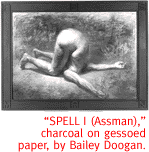

|

A New Collection By Bailey Doogan Is One Of The Strongest In Years.
By Margaret Regan
SEARING. LUMINOUS. Powerful: These aren't the kind of words
usually applied to drawings, but Bailey Doogan's 12 charcoal works
at the University of Arizona Museum of Art deserve every one of
them, and more. There's no getting around it. Bailey Doogan:
A Survey of Drawings: 1988- 1998, a drawing installation in
the UA faculty show, is one of the strongest exhibitions to open
in Tucson in ages.
A professor of painting and drawing, Doogan has commandeered
one whole room at the museum, covering its walls with giant, confrontational
charcoals of the naked human body, particularly the defiant flesh
of older women.
 There are two images of the dead.
There are two images of the dead.
The remains of a 3-year-old boy, a real-life child savagely beaten
by his mother's boyfriend in Tucson in 1987, float across the
paper in "C.A.N. Death (Child Abuse and Neglect)," 1990,
a charcoal and pastel on gessoed paper. His eyes are open, still
registering the look of puzzlement he must have cast on his murderer
at the moment of death. The glowing black and white of Doogan's
drawing re-sanctifies his tortured flesh and restores him to the
sacred. The only color is the red of the blood on his chest, and
the pastels of the ponies and pigs printed on the baby sheet that
is his shroud.
"The Hard Place (for Mairead Farrell)," 1990, a charcoal
and dry point on gessoed paper, is a wall-sized elegy for an Irish
woman slaughtered in Gibraltar by a British counter-insurgency
unit. An Irish Republican Army member, Farrell and two companions
were unarmed when the soldiers shot them at close range, according
to an informational sheet written by Doogan. The artist records
the red blood draining out of the dead woman's ear, but her rendering
of Farrell transcends the violent political oppression that led
to her death.
The black-and-white drawing, built in layers of charcoal and
gesso, is beautiful...and still. Farrell's body is draped in cloth
and its complicated cascade of folds flicker between shadow and
light. The monumental corpse cuts diagonally across the big sheet
of paper, endowing the composition with a classical dignity on
the order of "The Death of Marat," David's ode to a
leader of the French Revolution. Farrell's own words are inscribed
at the edges of the piece: She speaks of finding the hard place
within herself that her tormentors will never reach.
Doogan's merging of words with images has a link to her long-ago
work as an advertising artist. "Pour It On," a 1998
pastel on curved, gessoed linen, a re-do of her original design
for the Morton Salt Box, is a humorous nod to that advertising
past. This funny piece reunites her commercial art with her fine-art
concerns. Replacing the perky little girl under the umbrella is
an aging woman, the curves of her soft flesh lovingly detailed.
Woman's body re-imagined and re-imaged is one of Doogan's great
themes. She has long painted the changes in female bodies over
time, their soft flesh, as she puts it in an artist's statement,
"carry(ing) the evidence of weight, gravity, time and experience."
 One whole wall of drawings challenges our cultural discomfort
with these body changes, and probes limiting anti-woman stereotypes
of all stripes. "Angry Aging Bitch (RIB)" is a drawing
of three, near life-size female figures, facing forward confronting
the viewer, their older bodies realistic chronicles of their long
life histories. "Virgin/Whore (GO)" again pictures two
women, their identities rigidly conferred on them by the two labels
that once mapped out the whole of allowable female sexuality.
One whole wall of drawings challenges our cultural discomfort
with these body changes, and probes limiting anti-woman stereotypes
of all stripes. "Angry Aging Bitch (RIB)" is a drawing
of three, near life-size female figures, facing forward confronting
the viewer, their older bodies realistic chronicles of their long
life histories. "Virgin/Whore (GO)" again pictures two
women, their identities rigidly conferred on them by the two labels
that once mapped out the whole of allowable female sexuality.
Doogan has assayed her own face in a series of scratchboard drawings
from 1993. She doesn't stoop to self-flattery--she records the
wrinkles and droops in a wonderfully fine line--but she does make
of her own visage an encyclopedia of possibility. She draws the
face of a woman who doesn't accept false limits. Powerful in black
and white, this is a woman who shouts, who ponders, who purses
her lips; the face of a woman who takes all of life to be her
province.
Bailey Doogan: A Survey of Drawings: 1988-1998
continues through Tuesday, October 17, at the UA Museum of Art,
as part of the UA Art Faculty Exhibition. Museum hours
are 9 a.m. to 5 p.m. Monday through Friday, and noon to 4 p.m.
Sunday. For more information, call 621-7567.

|
 |





